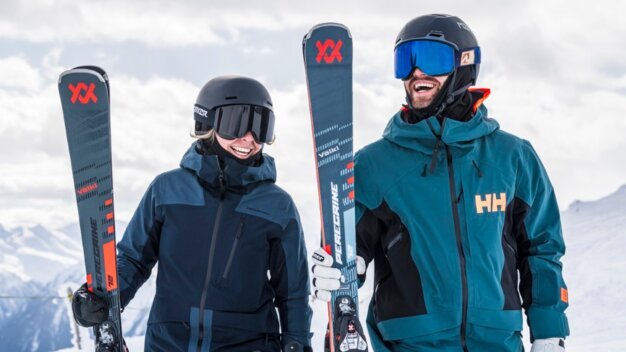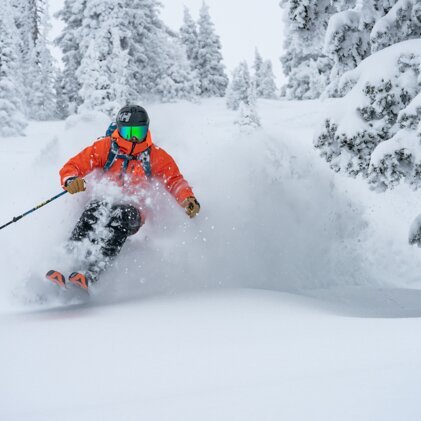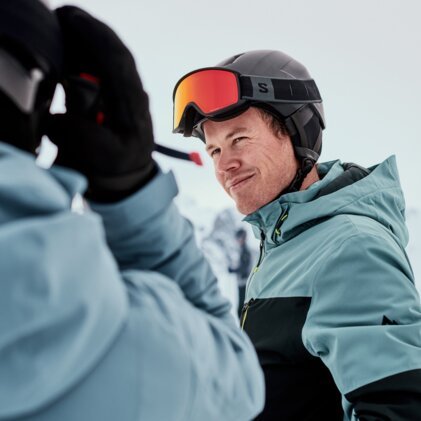
As a passionate winter sports enthusiast, you probably already know that an outfit consisting of several layers is the key to keeping you warm in the mountains. When skiing, the mid layer takes on this task. Thanks to the onion principle you can put on or take off individual layers of clothing as required to adapt to your own and the ambient temperature. Each layer has its own purpose.
So if the base layer is the foundation of a good layering system and the hard shell protects you from the elements, what is the role of the layer in between, the so-called mid layer? In this article, we take a look at its function and the materials used. Find out the benefits of a high-quality mid layer! INTERSPORT Rent and Helly Hansen have the most important information for you.
What is a mid layer?
As the name suggests, the middle layer is the centrepiece of your layering. It is part of the onion principle and separates itself on the outside from the hard shell and on the inside from the base layer.
Each layer has a specific function. A good mid layer:
- stores body heat.
- protects against the cold.
- is breathable.
- is lightweight.
- has a small pack size, depending on the material.
To ensure that the mid-layer works optimally during sporting activities, you should make sure that you buy breathable materials. The more intense the activity, the more important it is that moisture can be transferred from the inside to the outside. Otherwise, your skin or base layer will remain wet and there is a risk of you cooling down.
How a mid layer insulates
The trick behind how the middle layer works is simple. Materials that are used have very fine fibres, which turn into countless branches. The air collects inside these microscopically small air chambers and is warmed by the body's own temperature. The stored heat ensures that the upper body does not cool down. Incidentally, both synthetic and natural textiles are being used.
Which materials are used for skiing in mid-layers ?
As already mentioned, the main purpose of the mid layer is insulation. The more efficiently the layer prevents the heat emitted by the body from escaping and stores it, the warmer it is. The following materials are available to choose from:
Advantages and disadvantages of merino wool as a mid layer
Advantages:
- has odour-inhibiting properties
- is very hard-wearing
- does not need to be washed often
- offers good temperature regulation
- stores heat
- generates heat independently
- no scratching on the skin thanks to very fine fibres
- warms even when wet
Disadvantages:
- becomes heavy when the fibre is wet
- is quite expensive
- is not quite as breathable as synthetic fibres such as polyester
Advantages and disadvantages of synthetic fibres
Synthetic fibres are industrially produced and obtained from crude oil or recycling processes. In this context, it is important to note that synthetic fibres such as polyester, polyamide or elastane can take on different shapes and structures. This means that those textiles can be developed to mimic the properties of natural fibres (e.g. synthetic down).
Advantages:
- Soft to the touch
- dries quickly
- is long lasting
- very breathable
- keeps you warm even when damp
- has excellent moisture-regulating properties
Disadvantages:
- is not ideal for wet and windy conditions
- is less compressible than softshell or down and therefore more difficult to stow away
Advantages and disadvantages of down as a mid layer
Advantages:
- offers excellent heat retention
- is extremely light
- retains its shape
- is highly compressible (high Cuin value)
- loses its insulating effect when damp
Disadvantages
- requires special cleaning
- is relatively expensive
- loses its warming properties when wet
Which fibre you prefer depends on your liking, the intended use and your budget. Are you planning a ski tour on a warm spring day? Or do you want to undertake a multi-day traverse in the middle of winter? Depending on what you are planning, certain product features are more important than others. In addition, comfort and weight are always a question of personal preference. If you are unsure, our RENTertainers will be happy to advise you in one of our shops near you. Here you can try on the mid layer directly. It's best to take your ski jacket with you.
Tip: There are also hybrid forms that combine the advantages of synthetic fibres and natural fibres.
This is how a mid layer should fit
A mid layer should fit snugly, but not restrict your freedom of movement. If the mid layer is too tight, there is also a risk that the breathability of the functional underwear will be impaired. The optimum fit ensures that the mid layer fits well above the base layer and still fits well under the ski jacket. Too loose is also a problem, because cold air can penetrate the inside and the thermal insulation is lost.
Consequences at a glance:
- Too wide: Loss of warmth, draughts, lower insulation performance
- Too tight: Restricted freedom of movement, uncomfortable fit, poor moisture transport
Mid layer from Helly Hansen
As one of the world's most renowned manufacturers of outdoor clothing, Helly Hansen has plenty of experience in keeping winter sports enthusiasts warm. In 2018, the Swedish alpine skiing team, with whom they were was working with at the time, needed a lightweight and insulating layer that would keep them warm.
As a result Helly Hansen developed a new technology that paved the way for the perfect mid layer: LIFALOFTTM- based on a combination of the specially developed LIFA® fibres with PrimaLoft.®
Properties of LIFALOFTTM technology
- ... stores heat exceptionally well
- ... is extremely light
- ... has hydrophobic (water-repellent) properties
- ... is very breathable
- ... high wearing comfort even during the most intensive activities
Note: Although hydrophobic LIFA® fibres do not absorb water, they are designed in such a way that they allow moisture to pass through in the form of water vapour. Moisture is therefore not absorbed, but can diffuse through the airy structure between the fibres.
In short, Helly Hansen's LIFALOFTTMproducts fulfil all the criteria of a perfect mid-layer. So, if you are looking for an excellent mid layer, try the LIFALOFT HYBRID INSULATOR jacket, which is available in both women's and men's styles!
How to care for your mid layer
If your mid layer gets dirty, only the right care will help. The most important information can be found in the manufacturer's instructions. You should always follow these manuals, as the textiles are sensitive materials that can lose their shape or simply lose their function if not cared for properly. The rule is: as often as necessary, as little as possible.
In most cases, external dirt can be treated with lukewarm water and a soft cloth. Stains can be removed by using circular movements. If this does not help, special detergents or pH-neutral soaps for functional fibres can be used. However, bear in mind that different washing and drying processes are required for down, merino and synthetic fibres.
In our more than 800 locations worldwide we have a colourful selection of different mid layers as well as the corresponding care products. Our RENTertainers will be happy to advise you.
Frequently asked questions about mid layers in winter sports
What are the three layers of clothing?
Layering or the onion principle basically involves three layers of clothing. These include:
- Base layer
- Mid layer
- Hard shell
Each of these layers has a specific task. While the base layer absorbs and transfers moisture, the mid layer stores body heat. The outermost layer in turn guarantees protection against snow and wind.
What do you wear under a ski jacket?
What you wear under your ski jacket depends largely on the outside temperature. In spring, when temperatures on the mountain are warmer, a layer of ski underwear can be enough to keep you warm. In sub-zero temperatures, however, a mid layer is recommended as it retains body heat better and prevents you from cooling down.
What do you wear under a mid layer?
Basically, you wear ski underwear under a mid layer. This is another layer of functional underwear, also known as a base layer. Its task is to absorb moisture and pass it on to the layer above. In the best-case scenario, it keeps your skin dry and - depending on the material - guarantees optimum thermal performance.
INTERSPORT Rent tip
The RENTertainer recommends
Before you pick a mid layer off the shelf or order one from an online shop, you should answer the following questions for yourself: Do I sweat a lot or a little during the activities for which I need the extra layer? Or do I get cold quickly and how much budget do I have available? You can use these questions to determine the right layer of clothing. If you find it difficult to choose the right materials because of the different types of textiles and their names, our RENTertainers will be happy to help and advise you. Visit us at an INTERSPORT Rent shop near you.
Related articles
You may also be interested in:



